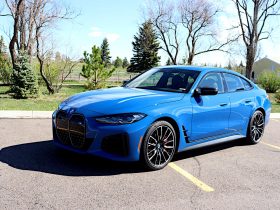Ford plans to introduce the next-generation of the Fusion Hybrid equipped as an autonomous development vehicle a both the Consumer Electronics Show (CES) and North American International Auto Show (NAIAS) during January 2017. The autonomous vehicle uses the same platform and hardware, but has new computers and processors to boost its ability to adapt and react.
Ford says that electrical controls are close to production-ready and sensor technology and placement is well-refined. A new LiDAR sensor unit has a more sleek, small design that gives a more targeted field of vision to the car. This allows just two instead of four sensors without losing data gathering input.
This new-generation Ford Fusion Hybrid ADV has been three years in development from the previous generation. Ford plans to have a commercially-available autonomous vehicle by 2021 to be launched as part of its ride-hailing and ride-sharing service connections.
To support that, Ford announced four key investments and collaborations that are expanding its strong research in advanced algorithms, 3D mapping, LiDAR, and radar and camera sensors:
- Velodyne: Ford has invested in Velodyne, the Silicon Valley-based leader in light detection and ranging (LiDAR) sensors. The aim is to quickly mass-produce a more affordable automotive LiDAR sensor. Ford has a longstanding relationship with Velodyne, and was among the first to use LiDAR for both high-resolution mapping and autonomous driving beginning more than 10 years ago.
- SAIPS: Ford acquired the Israel-based computer vision and machine learning company to further strengthen its expertise in artificial intelligence and enhance computer vision. SAIPS has developed algorithmic solutions in image and video processing, deep learning, signal processing and classification. This expertise will help Ford autonomous vehicles learn and adapt to the surroundings of their environment.
- Nirenberg Neuroscience LLC: Ford has an exclusive licensing agreement with Nirenberg Neuroscience, a machine vision company founded by neuroscientist Dr. Sheila Nirenberg, who cracked the neural code the eye uses to transmit visual information to the brain. This has led to a powerful machine vision platform for performing navigation, object recognition, facial recognition and other functions, with many potential applications. For example, it is already being applied by Dr. Nirenberg to develop a device for restoring sight to patients with degenerative diseases of the retina. Ford’s partnership with Nirenberg Neuroscience will help bring humanlike intelligence to the machine learning modules of its autonomous vehicle virtual driver system.
- Civil Maps: Ford has invested in Berkeley, California-based Civil Maps to further develop high-resolution 3D mapping capabilities. Civil Maps has pioneered an innovative 3D mapping technique that is scalable and more efficient than existing processes. This provides Ford another way to develop high-resolution 3D maps of autonomous vehicle environments Silicon Valley expansion.







